Offgrid Preparation Rapid Emergency Networks: Porch Vikings Amidst the Minneapolis Riots
In This Article
As Americans living in 2020, we each are searching on our own for a defining moment. We all do this to some degree, either actively in the pursuit of grand goals, or passively, waiting for life to bestow some sense of meaning. We do this with events too, attempting to put into perspective what something like the death of George Floyd or the subsequent burning of the Minneapolis Third Precinct means for America. These considerations typically take place in the aftermath of such events, invariably influenced by pundits, politicians, and people seeking to control narrative. In the moment, however, neighborhoods came together to protect local businesses and their own homes — and spontaneous Emergency Networks spread across the city. As a Minneapolis native, this first-hand narrative represents the antifragility of the American people.
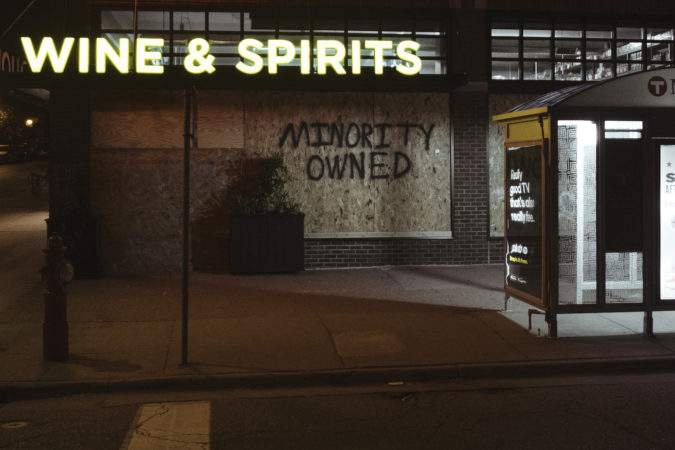
Above: Whether in solidarity or for camouflage, many businesses marked their own properties with the same phrases that those in the street were shouting, hoping it would keep them from getting looted.
As the façade of public safety went up in flames to the sounds of chanting, the eerie nature of the moment didn’t have time to sink in. This wasn’t a nightlong siege of an embassy in a foreign country — this was home. A phone call interrupted. Was it another family member? A friend calling to check in? Or was it word of something new?
In the background, flames leaped from buildings and smoke plumes melted into a dawn skyline. For miles, the smell left a slight metallic taste in the mouth. It wasn’t recognizable, but it was familiar.
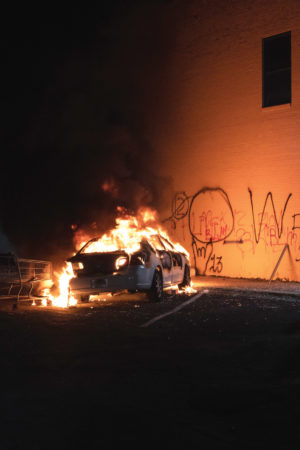
The city, this city, our city wasn’t the same in the morning air. All night we were monitoring, watching, and sending out patrols. Little did we know by the end of the week that we’d be convoying nursing mothers away from their homes to safety. Was this Minneapolis, or was it Mogadishu?
We were no longer measuring this event in hours, but days. The previous 24 hours we watched what started as protests turn into burning buildings and a form of looting that looked too relaxed to be anything but surreal. A man in socks and sandals stumbled out from the rubble of a smashed employee entrance with a carton of eggs, some cooking oil, and a half-eaten candy bar. With a casual air, he stepped around a barrier, chuckled at the hull of a burning car, and disappeared into the residential streets. A few miles away, men with body armor and carbines sat inside cars in grocery store parking lots and outside apartments to protect businesses and the community.
Sorting through and qualifying the information escalated to a necessity, as rumors spread like wildfire through social media and news outlets. The white supremacists were coming to town — or was it the Black Panthers? Boogaloo boys or antifa? Believable? Yes, but not nearly as relevant nor immediate as the gas station burning at the end of the block. The National Guard was now using live ammunition? A quick check with a friend in the chain of command said otherwise; another case of bad information reaching further and faster than fact.
It didn’t take long for rumors to breed distrust, with speculation spreading fear that some infamous “them” could be coming to town to take part in the trouble. But how could we verify who they were or where they were coming from, or even where they were going? And then there was the matter of who we were. Were we a group of concerned friends? A rescue operation? The latest evolution of the neighborhood watch?
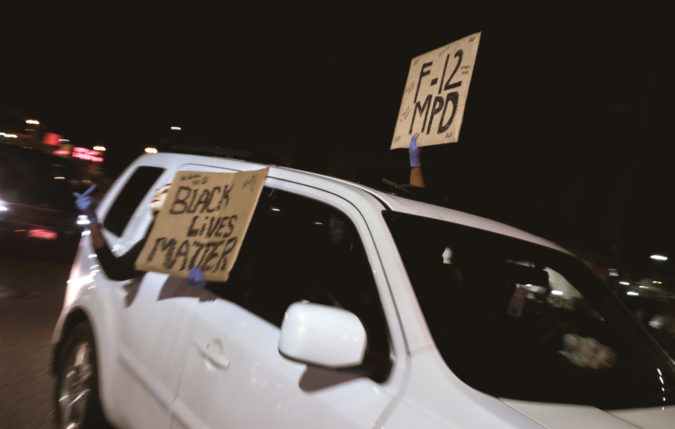
Above: A caravan of impromptu parades streamed across the city, through neighborhoods, blocking traffic. The closer you got to the epicenter, the less anyone concerned themselves with following the rules of the road.
On the couch rested a plate carrier, hearing protection, and a rifle. Half of the dinner table became a command center, busy with communication on every channel, texts, phone calls, live video, and each social media platform a blur of new information that had to be evaluated.
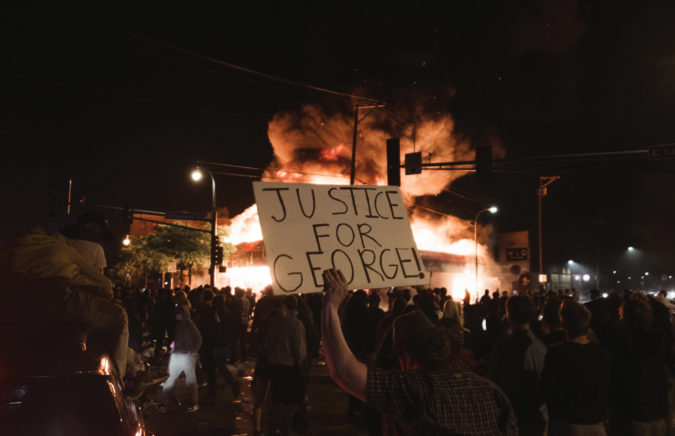
Above: Across the street from the 3rd Precinct, a family owned liquor store burned throughout the night as its merchandise was passed through the crowd, regardless of age.
When it all started, we simply called each other. Some of us were friends, others family, some as distant as former colleagues or a valued professor from years ago in college. A former coworker had left town, but he was monitoring the police chatter in our area through a scanner. Establishing the network was spontaneous. What came next couldn’t be. We had to systematize our communication — quickly — before it became too jammed up to do any good.
Nicholas Nassim Taleb, in his work Antifragile, observed that highly centralized organizations were prone to collapse when the head was cut off from communication. The world of Special Operations long ago incorporated this principle by maintaining an unwritten standard that each member of the team must be capable of performing the duties one or two levels above and below themselves. In emergencies, situations will escalate from bad to catastrophic when arguments over leadership take precedence over the threat at hand.
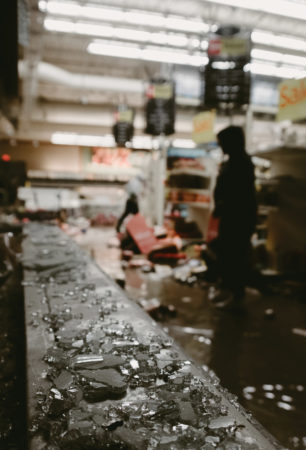

Above: As the looting continued, it became more and more banal. Soon windows were smashed just for the hell of it.
An emergency network stands apart by defining itself primarily around an area of operations, not a rank structure. It’s not an organization that needs hierarchy, but a team that requires cohesion. Spread across Minneapolis, each person represented a node, a point to gather and cross-reference any information that popped up. Some brought unique expertise — a retired police officer, a member of the National Guard, a nurse, another who was social media savvy. No bunkers, HAM radios, or bug-out Hilux imports in sight, all communication took place over cell phones and computers. By establishing various information-specific group text messages or chat rooms, we isolated pertinent, actionable information that could be shared across the whole group while limiting the noise of rumors and conjecture.
Next, we used tools like Google Earth to clearly define and disseminate where each person lived to determine key routes of travel and the greatest danger areas. People could drop a pin where they lived, and if they saw something first-hand, it could make its way onto the map. If a building started burning, it was shared with the group. As time progressed, various streets, roads, and highways would be blocked by police, protesters, or riots, and that’d determine how we’d get people out of a bad place.
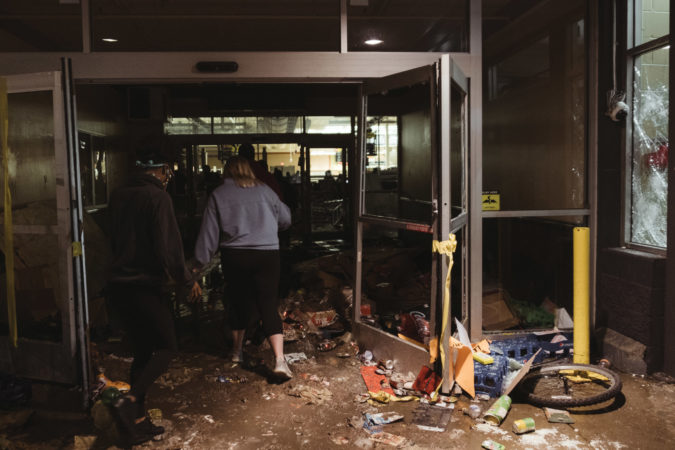
Above: Those looting the stores rarely looked like comic book villains. Many came just for the spectacle and went home with a free lunch.
When establishing a network as a crisis is in progress, the decentralized nature of the group begins naturally. By self-regulating the various streams of communication, the network prevents itself from getting too crowded, allowing the most pertinent information to stay on the top. By reserving phone calls for immediate threats, part of the team can get rest knowing that if they were needed the ringer would wake them up. Just as some streets set up shifts to keep watch over the neighborhood, so could the network look out for each of its members while some slept for the first time in 36 hours.
For the third night in a row, the city burned with no end in sight. As the skyline began to give way to the gray of dusk, we wondered if tonight we’d see it aglow by fires in this neighborhood. The rumor coursing through the wires and waves of the city was that tonight the rioters were going residential, now that the police precincts had hardened their defenses and the businesses worth looting had been stripped bare. All day, pallets of plywood emptied out of lumberyards for boarding up gas stations, liquor stores, and churches within a 20-mile radius.
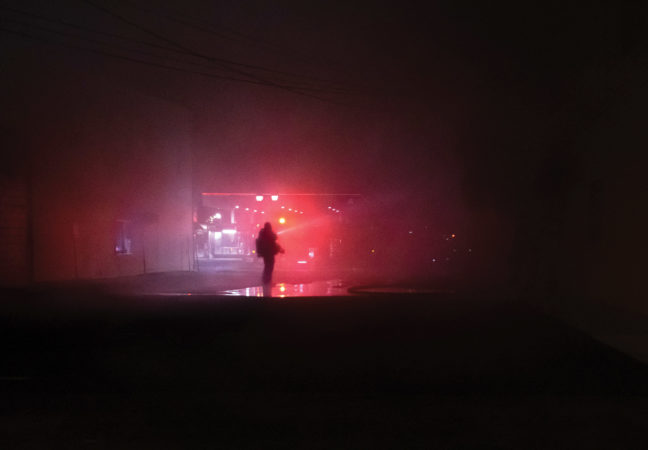
Above: Some parts of the city were wholly abandoned by the fire department, where in others struggled long into the night.
A computer had been synced to relay text messages, as it took too long to type on a phone keyboard. A screenshot came in, this time a social media post: THE WHITE SUPREMACISTS ARE MARCHING SOUTH FROM NEW BRIGHTON. If that were true, it would be a problem. Could this information be verified? We didn’t care about who they were, only if the threat was real.
We had more information at our fingertips than we could handle. In order to turn it into OSINT (open-source intelligence), or actionable information, we needed a way to evaluate what came in. People flocked to Minneapolis, some for a chance to get in on the action, others to catch the spotlight for political gain, still more to protect property and people from the fires, or to watch what felt like history in the making. All the attention brought a spotlight and the struggle for it.
The battle over the streets was matched with a battle over the headlines. That distinction meant everything to those who lived where others fought. In the papers and across the web, people argued over who was starting the fires, or who was coming to town, but to us, it didn’t matter — we sent an armed escort to the home of a National Guardsman who was receiving threats. As the street violence continued to escalate, he’d been called in, leaving his wife and 1-year-old child home alone. Despite the curfew, they were quickly and quietly escorted to the safety of family outside the city.
It wasn’t the alarm of white supremacists on Twitter that drove us to action, but the reports coming in from government sources and confirmed by our own people on the ground. When rumors of threats began to spread, it became the responsibility of each person to verify what they heard and dismiss anything that couldn’t be confirmed. In this case, the National Guard was briefed on the expectation for the riots to move into residential areas, and we considered it actionable intelligence when multiple vehicles were spotted driving through without license plates. The previous days’ reports and videos floated across Minneapolis, depicting cars stripped of tags driving through in search of soft targets to quickly smash-and-grab them when the police were nowhere in sight.
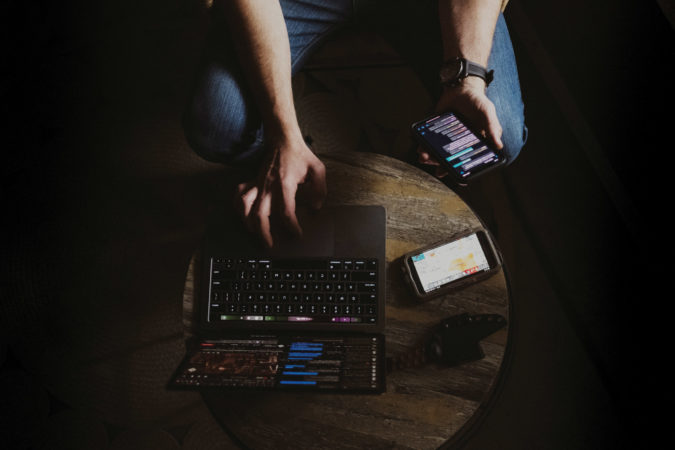
Above: From their porches, streets, and rooftops, citizens watched the chaos unfold, holding down their little section of home. In situations like this, a KAGWERKS protected phone designated for navigation with ATAC or similar programs is vital, especially if tracking multiple moving parts such as threats and friends.
The saying “trust but verify” pertains to more than just leadership strategies, especially for information that could qualify as OSINT. An emergency network remains flexible by operating with a decentralized structure, but it relies on a systematized approach to information and the responses. New information is sifted according to its credibility and then assigned triggers that warrant specific actions. Social unrest seized Minneapolis in a matter of hours, so the establishment of an emergency network was both organic and reactionary. However, once the channels of communication were established, it was time to become proactive. This meant forming an amalgamation of tactics and standard operating procedures. With people remaining in their neighborhoods, sometimes minutes and sometimes miles apart, we needed to know exactly when it was time to act and how to act.
As we tracked the movement of the riots, mapping out the locations of burning or looted buildings, we were faced with this question. So far, none of us had been immediately threatened. Our hatchets sharp, powder dry, and plate carriers loaded, our team was at the ready, but as the violence escalated, it stayed away from our doorsteps. Our greatest danger wasn’t a torch-wielding mob — at least not yet — but rather the weariness of endlessly waiting for a threat to manifest, hoping that we’d have the mental fortitude to make wise decisions.
Tangible triggers dictate appropriate responses. When someone identified vans without license plates roving around their neighborhood, someone outside of the danger area would drive to their location and provide security for the night. If someone needed food but couldn’t leave their home, another would provide a meal. In the event of a nearby fire, people with trucks were at the ready, fully knowing the hazard of entering a part of the city barred from police, medical responders, and even the fire department.
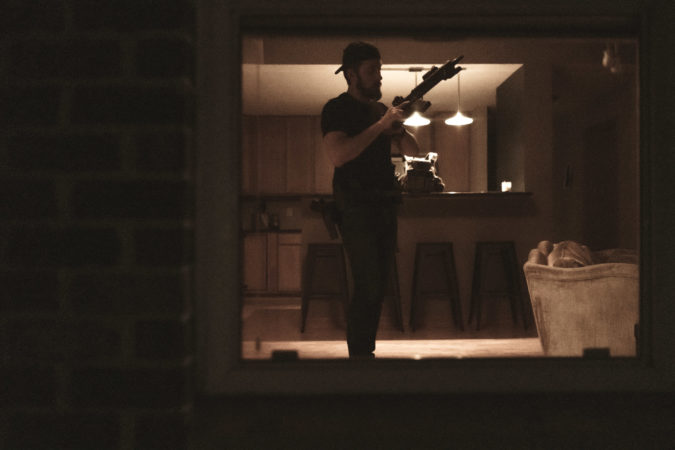
Above: Maintaining the “Minnesota Nice” exterior as some marched to defund the police, others prepared for the crime wave that would soon follow.
By establishing triggers, each tied with predetermined response, the team moved from a reactive posture to proactive planning. As the unrest progressed, fear spread through rumor gave way to a systematized evaluation of information. This evolved further to make room for the network to look for ways to improve our position, instead of waiting for bad news to come home.
In the weeks following the riots, after the fires had long gone out and the smoldering wreckage of businesses began to assess how or if they could rebuild, some looked to politicians to save them from the aftermath. Our network, however, remained in place to look after our own. No one was coming to save us, and this was our home. This city was ours, but its eyes had grown wide with suspicion as it questioned who could be trusted. Neighbors debated who started the fires or looted local businesses, and the machine of media turned its attention from reporting on what it saw to arguing over which politician was to blame.
Behind the scenes, men and women stood up to look after each other, not by obligation but by choice. And it was that conscious decision that set them apart. No longer burdened by a search for meaning, they had found theirs — not in trying to identify victimhood, but to act and make themselves more able to act. In Minneapolis, behind the politics and the posturing, these emergency networks still stand, defined not by what happened to them, but what they were doing when no one was looking.
Photography by Samantha Lauraina
[Editor's Note: This article first appeared in RECOIL #52]
 STAY SAFE: Download a Free copy of the OFFGRID Outbreak Issue
STAY SAFE: Download a Free copy of the OFFGRID Outbreak Issue
No Comments